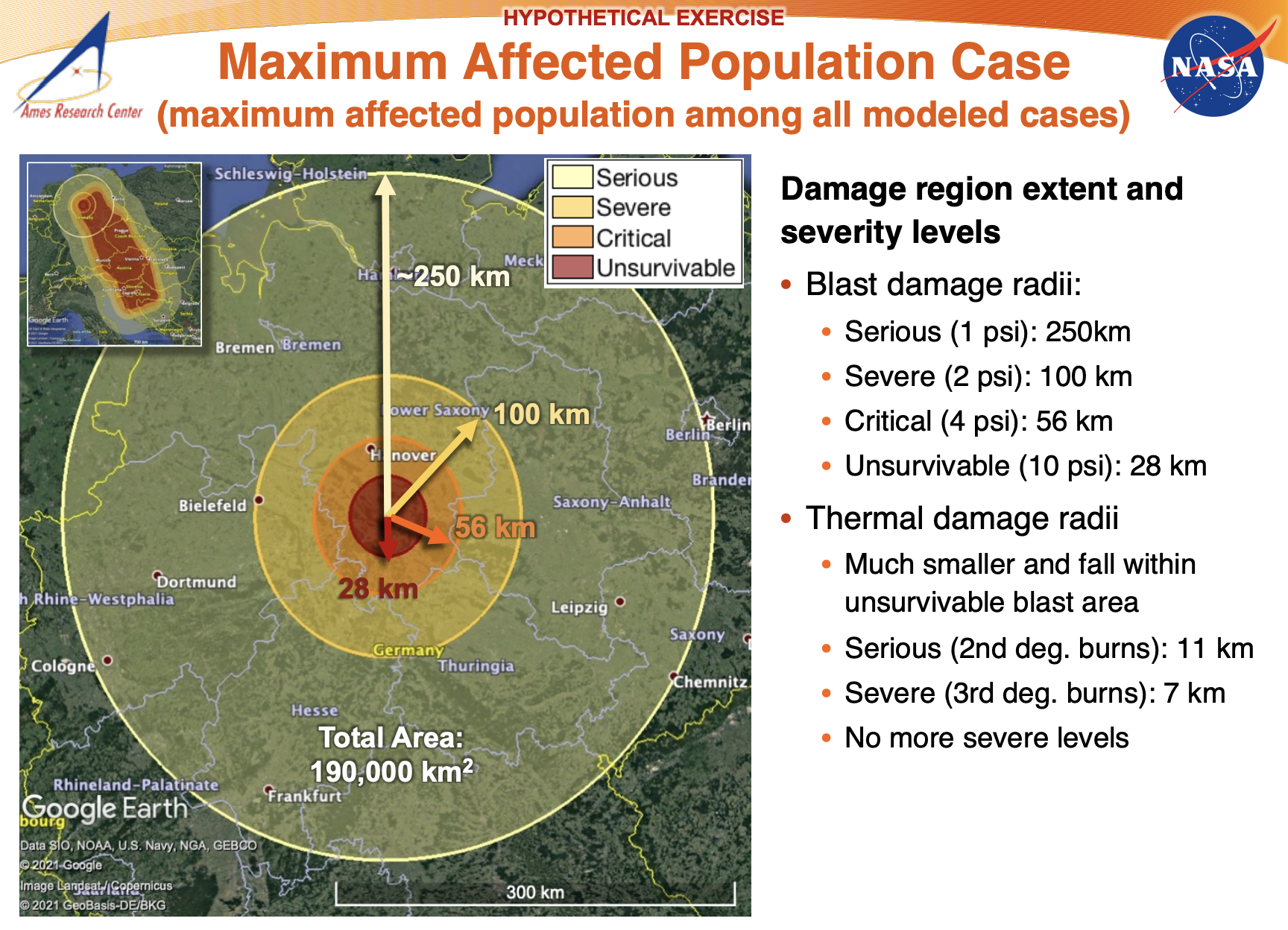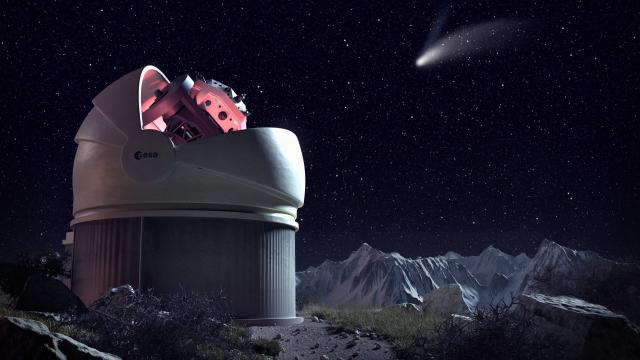A fictitious asteroid is headed our way, and a group of real experts is currently doing their best to deal with the grim situation. The week-long tabletop exercise, now in its third day, aims to find out whether our current technologies, systems, and institutions could handle the crisis if an actual asteroid were to threaten Earth any time soon.
During the Fukushima nuclear disaster in 2011, fire trucks were desperately needed at the plant. It seemed like a straightforward request, except for one rather alarming development — the roads were blocked on the way into the facility owing to the tremendous damage caused by the tsunami. It was an understandable oversight, but perhaps something that could’ve been foreseen.
Indeed, disasters may be notoriously unpredictable, but that doesn’t mean we should refrain from the attempt. Hence the importance of these tabletop exercises. By going through the motions of a disaster, we can foresee how a situation might actually unfold and evaluate various responses to an actual emergency.
One of the most frightening disaster scenarios is an asteroid impact. As far as we can tell, no known asteroid poses a significant threat to our planet at any point in the near future, but that could quickly change should a potentially hazardous asteroid suddenly come into view.
With that dark possibility in mind, NASA’s Jet Propulsion Laboratory’s Centre for Near Earth Object Studies is currently leading a simulation of an impact scenario. Over the course of this five-day event, participants assume various roles, such as a national government, space agency, astronomer, civil protection authority, and so on. The group receives daily briefings about the unfolding situation, requiring them to think each situation through and respond accordingly.
As NASA points out in a press release, this simulation, which includes both U.S. and international partners, is being done to “investigate how near-Earth object (NEO) observers, space agency officials, emergency managers, decision makers, and citizens might respond and work together to an actual impact prediction and simulate the evolving information that becomes available in the event an asteroid impact threat is discovered.”
The event started this past Monday, April 26, and it’s happening at the annual IAA Planetary Defence Conference, which is being hosted by the UN’s Office for Outer Space Affairs in cooperation with ESA. It is currently day three of five, and details of the exercise are being made available at the CNEOS website. This is the seventh exercise of its kind, and it’s done every two years. In 2019, the planners accidentally destroyed New York City in an attempt to save Denver, so yeah, it can get a bit intense.
Before the tabletop simulation got started, the participants were given a preliminary description of the invented threat: An asteroid named “2021 PDC” was discovered on April 19, 2021 by astronomers in Hawaii. The object is 57 million km away, and its closest approach to Earth will happen on October 20, 2021 — a mere six months from now. The probability of impact was initially assessed at 1 in 2,500, which is relatively low. Importantly, however, this estimate was based on just two days of observations. The size of 2021 PDC couldn’t be discerned, with estimates between 35 metres and 700 metres.
As an aside, an actual organised response to a potentially hazardous asteroid would be triggered when the threat is 1 in 100. This is significant because the scenario worsened dramatically on Day 1 of the tabletop exercise, when the participants were told that the odds of a collision were re-evaluated at 1 in 20, or 5%. In addition, the group was shown maps of Earth, identifying a possible impact area that stretched across two-thirds of the entire planet.
Dear reader, please keep in mind that all of this is fake. 2021 PDC doesn’t actually exist, you are safe, and there’s no need to panic. Cool? Cool.

Yesterday, on Day 2 of the exercise, the participants were told that the asteroid has a 100% chance of smashing into the Earth on October 20. The asteroid will strike somewhere in Europe or northern Africa, but the size of the object remained unclear, making assessments of the potential damage difficult to predict.
Equipped with this knowledge, the team began to brainstorm mitigation strategies, such as intercepting the asteroid to steer it off course or smashing it with nuclear weapons. After thinking it through, however, the team concluded that, had this been the real deal, “we would not be able … to launch any spacecraft on such short notice with current capabilities.” Indeed, the most viable plan called for launch on May 1, which ain’t happening.
This proved to be a teachable moment. In its Day 2 report, the team declared that enhanced detection abilities, like NASA’s upcoming NEO Surveyor space-based telescope, “can prevent short warning scenarios.” Even a flyby reconnaissance spacecraft would’ve helped, as such a mission could “significantly reduce the uncertainties faced by disaster response planner.”

On Day 3 — today — the team was given a more precise geographical range for the impending impact: an area in central Europe stretching 800 km long by 250 km wide. (Day 3 assumes two months have elapsed since the asteroid was first detected.) Threatened countries include Germany, Czech Republic, Austria, Slovenia, and Croatia. Mercifully, the size estimate of the asteroid was reduced to around 140 metres wide, “which significantly reduces the worst-case size and corresponding worst-case impact energies,” according to today’s report.
But that’s not to say the fake asteroid won’t inflict serious damage. As today’s report states, there’s a 21% chance that more than 1 million people will be affected and a 74% chance that more than 100,000 people will be affected. In a worst-case scenario, 6.6 million people would be affected across a region measuring 250 km out from the point of impact. Primary hazards include an airburst, the impact itself, and “thermal damage.”

Many uncertainties still exist about the situation, including the actual size and physical properties of the asteroid and the size of the threatened area. But seeing as no “in-space mitigation options are possible — civil emergency response is critical,” according to today’s report. It’ll be interesting to learn of the developments in Day 4 and Day 5, scheduled for tomorrow and Friday, and how the team will respond. I’m personally curious about mass evacuation efforts and how government officials plan on pulling that off in an orderly and safe manner. Definitely an easier-said-than-done type situation.
Again, this is all hypothetical and none of it is real. But this exercise reminds us that we need to keep a close watch on the night skies. Thankfully, we’re developing the tools to do this. In addition to NASA’s upcoming NEO Surveyor telescope, there’s ESA’s second Test-Bed Telescope, dubbed TBT2, in Chile, which just went into operation, and ESA’s Flyeye Telescope currently being built in Italy.
We’re also developing the tools to prevent an impact from actually happening, namely NASA’s Double Asteroid Redirection Test (DART), which is slated to become the first demo of an actual asteroid deflection. DART will launch later this year and smash into asteroid Dimorphos in late 2022, which it will do to change its orbit in space.
When it comes to asteroids, we may be sitting ducks, but hopefully not for long.
